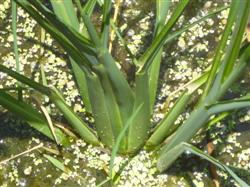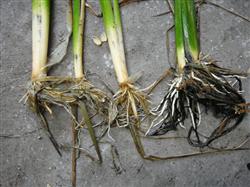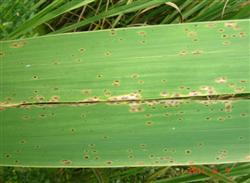Causes and prevention of male transformation of Zizania caduciflora

In the process of planting Zizania latifolia, there are often plants with flowering stems but not Zizania caduciflora, which are called "male Zizania latifolia" or "strong Zizania latifolia". Zizania caduciflora lost the ability of bolting, flowering and fruiting after being infected with smut fungus, and the flower stem expanded to form Zizania caduciflora. The spread of smut pathogen was mainly from the main stem of the previous year to the young seedlings. Although the underground stem has spread, but the transmission rate is very low. Therefore, if the underground stem is used to propagate for many years, the number of male Zizania latifolia will increase, and eventually lead to no production of Zizania caduciflora. Therefore, the control measure is to select the plants bearing Zizania latifolia as seeds so that the smut pathogen can be passed on from generation to generation. For example, if Zizania latifolia leaves seeds in one season a year, let its plants wither naturally and transplant them with buds drawn from the clumps or edge of the clumps in the second year, and the same method can be used later. If you keep seeds in two seasons a year, you should dig out most of the Zizania caduciflora plants that withered in winter and leave a small part in the middle. When they tiller in the second year, they should also dig out the seedlings from the ground or use the method of dividing piers, which is also effective. In this way, it can not only retain its excellent characteristics, but also bear more Zizania caduciflora. Zizania caduciflora is not allowed to be cropped continuously, and it is generally appropriate to use the 3-year ring for 5 years. This is also an important means to control the emergence of "Xiongjiao". In addition, in the field management, the male Zizania latifolia should be pulled out in time, because the male Zizania latifolia grows strongly, the aboveground part of the plant is tall and takes up space; when the stolon of the underground part is more than 1 m long, it will not only affect the growth of the surrounding Zizania caduciflora, but also be planted in the field as a normal tiller in the next year.
- Prev

New techniques of early ripening cultivation of Zizania caduciflora covered in greenhouse
The main diseases of Zizania caduciflora are rust, flax spot and sheath blight. The prevention and control of Zizania caduciflora disease must be based on agricultural control and comprehensive management must be carried out. Select disease-resistant varieties, do a good job in winter garden cleaning, reasonable close planting, strengthen fertilizer and water management, manually peel off yellow leaves and diseased leaves, at the same time reasonable chemical control, spray protection in the early stage of the disease.
- Next

High temperature and high humidity Zizania latifolia is prone to flax leaf spot.
Leaf spot of Zizania caduciflax is a fungal disease. In recent years, with the increasing area of Zizania caduciflora, the scope of the disease has gradually expanded, and the disease is becoming more and more serious. The disease can occur in the whole growing period of Zizania caduciflora. The main harm to the leaves, the initial appearance of yellow-brown spots on the leaves, and then expanded into sesame-sized brown spots, a few into.
Related
- Where is it suitable to grow horseradish in China? it is expected to see the middle altitude horseradish in Alishan.
- How to prevent tomato virus disease reasonably? (Control methods included)
- Many people like to plant towel gourd on the balcony. What are the main points of this method and management?
- What crops can chili peppers be mixed with?
- Fertilization techniques and matters needing attention in Tomato
- What are the grafting techniques for peach seedlings in spring?
- Harm and control methods of root swelling disease of Chinese cabbage
- What are the pests of sweet potatoes? How to prevent and cure it?
- Symptoms, causes and Control methods of navel Rot in Tomato
- The cause of "Cucumber rotten bibcock" in Farmers' planting Cucumber and its Control Plan

